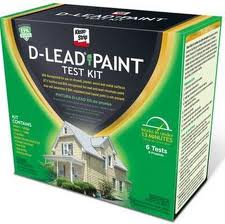 Sometime ago, I wrote a blog about what to test and what would be considered an integrated whole. It seems now, that the EPA RRP FAQ have put the controversy to rest.
Sometime ago, I wrote a blog about what to test and what would be considered an integrated whole. It seems now, that the EPA RRP FAQ have put the controversy to rest.
Question:
I’m a certified renovator using an EPA-recognized lead test kit to determine whether or not I have to follow the Renovation Repair and Painting (RRP) Rule work practices. What components must test negative for lead-based paint in order to qualify for the exclusion in 40 CFR 745.82(a)(2)?
Answer:
Generally, a certified renovator using an EPA-recognized test kit must test each building component to be disturbed. The only exception to this requirement is when the components make up an integrated whole. In such a case, one or more component(s) may represent a system of components, unless it is obvious to the renovator that the components have been repainted or refinished separately.
A staircase, for example, is made up of numerous repeating components which can be grouped together as integrated wholes for testing purposes. For these purposes, staircase components can be grouped into the following integrated wholes: (1) treads and risers, (2) balustrades, (3) newel posts, (4) railing caps, and (5) stringers. A single individual staircase component (e.g., a baluster) may represent the remaining staircase components of the same group (i.e., the rest of the balustrades on the staircase) unless it is obvious to the renovator that the components have been repainted or refinished separately. Therefore, where an entire staircase is to be disturbed, EPA believes it will be necessary to test five surfaces: one tread or riser, one balustrade, one newel post, one railing cap, and one exposed stringer. So long as it is not obvious that the components have been repainted or refinished separately, a negative test for lead-based paint on an individual staircase component in each of these groups would mean that a renovation on that particular staircase could be performed without regard to the RRP work practices.
EPA also believes it appropriate to apply the integrated whole concept to windows and doors. For testing purposes, window and door components can be grouped into the following integrated wholes: (1) the window or door assembly and (2) the window or door trim. Window assembly components include the sashes, stops, head, jambs, sill or stool, and trough; door assembly components include the door slab(s), jambs, head, sill and threshold. As a practical matter, it is likely that interior and exterior surfaces of window and door assemblies were repainted or refinished separately and should be tested separately. Therefore, where both the window/door assembly and trim will be disturbed (e.g., a full-frame window/door replacement), EPA believes that it will be necessary to test four surfaces: one interior window/door assembly component, one interior window/door trim, one exterior window/door assembly component, and one exterior window/door trim. However, if you only disturb paint on the interior or exterior of a window then you only need to test the assembly and trim on that side. If it is not obvious that the components have been repainted or refinished separately, a negative test for lead-based paint on a component in each of these groups would mean that a renovation on that particular window or door could be performed without regard to the RRP work practices.
NOTE: Each window, door and staircase to be disturbed must be separately tested, even if in the same room. Also, negative testing results must still be documented in accordance with the recordkeeping and reporting requirements of 745.86(b)(1)(ii) and (iii), and 745.86(a) and (c). See also FQ 23002-18220.

Great article about lead paint. I will have have to look into the lead paint test kit for my customers.
Thanks Damon! LeadCheck is a little easier to use in my opinion, but both have been tested by EPA. It is important to note that test kits do provide false positives quite often. In other words, it says it is lead based paint, when in reality … it isn’t. But better false positives than false negatives.
I attended the class at one of the locations on the EPA Lead Training. I’m glad I went through the class as I learned new practices for my jobs. Lead paint in the is a serious health hazard. A lead inspection is the first step to assess in order to avoid problems in the near future.